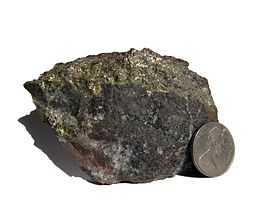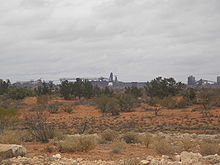Olympic Dam
| Olympic Dam Mine | |||
|---|---|---|---|
| General information about the mine | |||
| Chalcopyrite-rich ore piece from Olympic Dam | |||
| Mining technology | Underground mining | ||
| Information about the mining company | |||
| Operating company | BHP Group | ||
| Start of operation | 1988 | ||
| Funded raw materials | |||
| Degradation of | Copper / uranium / gold / silver | ||
| Greatest depth | 2200 m | ||
| Degradation of | uranium | ||
| Raw material content | 0.028% | ||
| Greatest depth | 2200 m | ||
| Degradation of | gold | ||
| Degradation of | silver | ||
| Geographical location | |||
| Coordinates | 30 ° 26 ′ 0 ″ S , 136 ° 50 ′ 0 ″ E | ||
|
|||
| Location | Roxby Downs | ||
| State | South Australia | ||
| Country | Australia | ||
Olympic Dam is a mining and processing center for copper , uranium , gold and silver in the center of the state of South Australia in Australia . Olympic Dam is currently the largest underground mine in Australia. The deposit currently represents the fourth largest known resource for copper and gold and the third largest known resource for uranium. At times, a massive expansion of production and the development of the deposit in open-cast mining was prepared (now postponed). The owner has been the BHP Group since 2005 .
geography
The mine and deposit are named after a water retention basin that a local farmer created in 1956 and named the Olympic Dam in honor of the Olympic Games that were just taking place. The mining complex is located west of Lake Torrens Salt Lake in the Roxby Downs Municipal Council . The majority of the approximately 2900 employees live in Roxby Downs . The small town was founded in 1987 as a workers' settlement south of the mining area and has now grown to around 4,000 inhabitants. The nearest towns are the opal mining town of Andamooka, 30 km away, and Woomera, 60 km south on the Stuart Highway , which runs from Adelaide to Darwin .
history
In 1969 Western Mining (WMC) began looking for copper deposits in central South Australia. After evaluating geophysical data, the first successful exploratory boreholes were drilled in 1975. Commercial mining began in 1988 with a relatively modest annual production of around 45,000 tons of copper, 1,000 tons of uranium oxide and gold and silver as by-products. After several expansions, the annual production is now 200,000 t of copper, 4,500 t of uranium oxide, 80,000 ounces of gold and 800,000 ounces of silver.
The government of South Australia passed the Roxby Downs Act in 1982, which exempted the mine from various legal requirements. The local administration, to which only Roxby Downs and the Olympic Dam mine belong, were given special rights with this measure.
In 1999 a contract was signed between WMC and several Aboriginal organizations, which approved an expansion of the mining area and the construction of a power supply.
In June 2005, BHP Billiton acquired WMC Resources for A $ 9.2 billion. An economic study examined a massive expansion of production. The southern part of the deposit was to be developed using an opencast mine. A seawater desalination plant to be built in Port Augusta , 300 km south, should relieve the current supply from fossil groundwater. In April 2009, BHP Billiton finalized and published the Environmental Impact Statement. In August 2012, BHP announced that it would not carry out the $ 30 billion expansion as planned because it would be too capital-intensive given the fallen copper price.
Deposit
Olympic Dam belongs to the group of iron oxide copper gold deposits (IOCG, iron oxide copper gold), it is considered to be the prototype for this group of deposits, which was unknown before the discovery of Olympic Dam. The deposit is located in an approximately 1.58 billion year old granite , which is overlaid by approximately 300 m thick Neoproterozoic sediments. Hydrothermal processes have brecciated the granite and enriched it with iron, copper, uranium, gold, silver and rare earth metals .
The deposit has a circular shape in plan with a narrow extension to the northwest about 5 km long. Civil engineering is currently taking place in the north-western section, while open-cast mining is to open up the circular center. The proven resource of the deposit is 8.3 billion tons of ore grading 0.8% copper, 0.028% uranium oxide and 0.5 g / t gold. The ore deposits currently being extracted from the northern part contain roughly twice as high shares. The ore deposit extends to a depth of at least 2,200 m.
Large industrial plant
On the mine site there is a large-scale facility that is unique in Australia and contains a hydrometallic concentrator for uranium and copper, a smelter and an electrolytic refinery.
Olympic Dam's production in 2011 was 194,100 tons of copper, 4,045 tons of uranium oxide, 111,368 ounces of gold and 982,000 ounces of silver.
See also
Web links
- BHP Billiton to the Olympic Dam Mine
- Olympic Dam Environmental Impact Statement
- BHP Billiton's Olympic Dam , by Stephanie Abela
- baddevelopers.green.net.au
- mining-technology.com: Olympic Dam Copper-Uranium Mine, Adelaide, Australia
- 1. Aachen excursion to Australia 2003, visit to the Olympic Dam mine
- Roxby Downs (Indenture Ratification) Act 1982
- Pirsa Minerals: Environmental Reports on Olympic Dam
swell
- ↑ roxbydowns.com: Roxby Downs Council ( page no longer available , search in web archives ) Info: The link was automatically marked as defective. Please check the link according to the instructions and then remove this notice.
- ↑ ausimm.com.au: Agreements between Mining Companies and Indigenous Communities ( Memento of the original from March 4, 2007 in the Internet Archive ) Info: The archive link was inserted automatically and has not yet been checked. Please check the original and archive link according to the instructions and then remove this notice.
- ^ Olympic Dam Expansion Project - Draft Environmental Impact Statement
- ^ Olympic Dam Update. Retrieved August 26, 2012 .
- ^ Olympic Dam Expansion Postponed. (No longer available online.) Archived from the original on August 25, 2012 ; Retrieved August 26, 2012 . Info: The archive link was inserted automatically and has not yet been checked. Please check the original and archive link according to the instructions and then remove this notice.
- ↑ The bright sound of uranium . in: FAZ of May 20, 2011, page 12
- ↑ pir.sa.gov.au ( Memento of the original from April 1, 2012 in the Internet Archive ) Info: The archive link was inserted automatically and has not yet been checked. Please check the original and archive link according to the instructions and then remove this notice. (PDF; 251 kB): Ken R. Bempton: Copper mining und treatment in South Australia , p. 39, in MeSA Journal January 28, 2003, in English, accessed on March 14, 2012
- ↑ mining-technology.com : Olympic Dam Copper-Uranium Mine, Adelaide, Australia , in English, accessed on March 21, 2012



